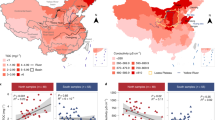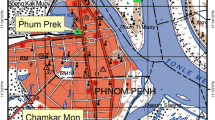Abstract
This investigation conducted a full-scale survey the drinking water distribution system in Kaohsiung city, Taiwan. The aim was to investigate whether the distribution system was capable of maintaining high water quality from the water treatment facilities through to the end user. The results showed that the distribution system can maintain high water quality, except for suitable chlorine residuals. The authors plotted chlorine residual contour maps to identify areas with low chlorine residuals, helping them prioritize sections that must be flushed or renewal. The contour maps also provide sufficient and clear information for locating booster chlorination stations. Contour maps enable water facilities to identify how water quality decays in the distribution systems and the locations of such decay. Water quality decay can be caused by properties of pipeline materials, hydraulic conditions, and/or biofilm thickness. However, understanding the exact reasons is unnecessary because the contour maps provide sufficient information for trouble-shooting the distribution systems.
Similar content being viewed by others
References
APHA (1995). Standard methods for the examination of water and wastewater (19th ed.). Washington: APHA.
Baribeau, H., Prevost, M., Desjardins, R., & Lafrance, P. (2001). Changes in chlorine and DOX concentrations in distribution systems. Journal of the American Water Works Association, 93(12), 18’2.
Boccelli, D. L., Tryby, M. E., Uber, J. G., & Summers, R. S. (2003). A reactive species model for chlorine decay and THM formation under rechlorination conditions. Water Research, 37(11), 2654’666.
Clark, R. M., Abdesaken, F., Boulos, P. F., & Mau, R. E. (1996). Mixing in distribution system storage tanks: Its effect on water quality. Journal of Environmental Engineering, 122(9), 814’21.
Delahate, E., Welté, B., Levi, Y., Leblon, G., & Montiel, A. (2003). An ATP-based method for monitoring the microbiological drinking water quality in a distribution network. Water Research, 37(15), 3689’696.
Dukan, S., Levis, Y., Piriou, P., Guyon, F., & Villon, P. (1996). Dynamic modeling of bacterial growth in drinking water networks. Water Research, 30(9), 1991’002.
Haas, C. N., Gupta, M., Chitluru, R., & Burlingame, G. (2002). Chlorine demand in disinfecting water mains. Journal of the American Water Works Association, 94(1), 97’04.
Islam, M. R., Chaudhry, M. H., & Clark, R. M. (1997). Inverse modeling of chlorine concentration in pipe networks under dynamic condition. Journal of Environmental Engineering, 123(10), 1033’040.
Kirmeyer, G. J., Friedman, M., Martel, K. D., Noran, P. F., & Smith, D. (2001). Practical guidelines for maintaining distribution system water quality. Journal of the American Water Works Association, 93(7), 62’5.
Lou, J. C. (2005). The survey of distribution systems on drinking water quality in Kaohsiung City, Project Rept. of TWSC (in Chinese). Taiwan, ROC.
Martel, K. D., Kirmeyer, G. J., Murphy, B. M., & Noran, P. F. (2002). Preventing water quality deterioration in finished water storage facilities. Journal of the American Water Works Association, 94(4), 139’50.
Rodriguez, M. J., & Sérodes, J. B. (1999). Assessing empirical linear and non-linear modeling of residual chlorine in urban drinking water systems. Environmental Modelling & Software, 14(1), 93’02.
Rodriguez, M. J., West, J. R., Powell, J., & Sérodes, J. B.(1997). Application of two approaches to model chlorine residuals in Severn Trent Water Ltd (STW) distribution systems. Water Science and Technology, 36(5), 317’24.
Rossman, L. A., Uber, J. G., & Grayman, W. M. (1995). Modeling disinfectant residuals in drinking-water storage tanks. Journal of Environmental Engineering, 121(10), 752’55.
Suffet, I. H., Corado, A., Chou, D., & McGuire, M. J. (1996). AWWA taste and odor survey. Journal of the American Water Works Association, 88(4), 168’81.
Tryby, M. E., Boccelli, D. L., Koechling, M. T., Uber, J. G., Summer, R. S., & Rossman, L. A. (1999). Booster chlorination for managing disinfectant residuals. Journal of the American Water Works Association, 91(1), 95’08.
Turgeon, S., Rodriguez, M. J., Thériault, M., & Levallois, P. (2004). Perception of drinking water in the Quebec City region (Canada): The influence of water quality and consumer location in the distribution system. Journal of Environmental Management, 70(4), 363’74.
Yeh, T. F. (1999). Environmental chemistry. Upper Saddle River, N.J.: Prentice Hall.
Author information
Authors and Affiliations
Corresponding author
Rights and permissions
About this article
Cite this article
Lou, JC., Han, JY. Assessing water quality of drinking water distribution system in the South Taiwan. Environ Monit Assess 134, 343–354 (2007). https://doi.org/10.1007/s10661-007-9625-2
Received:
Accepted:
Published:
Issue Date:
DOI: https://doi.org/10.1007/s10661-007-9625-2




